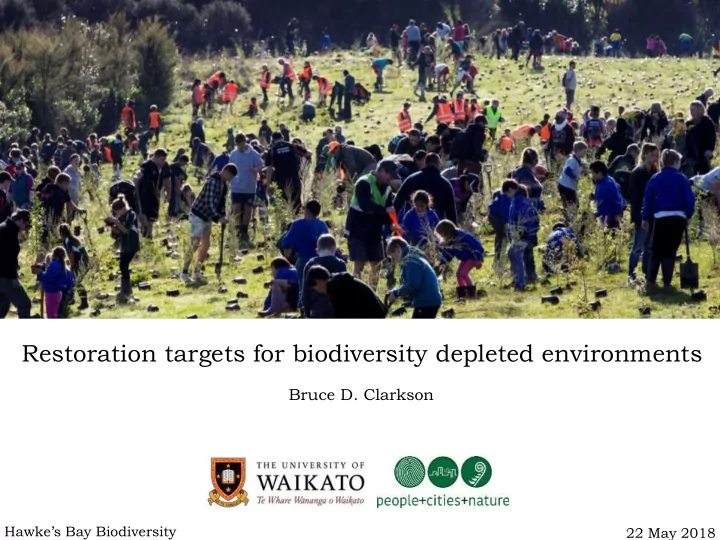

Restoration targets for biodiversity depleted environments Bruce D. Clarkson Hawke’s Bay Biodiversity 22 May 2018
The threatened environment classification Indicates how much indigenous cover remains, and therefore, differing levels of threat. It illustrates how past loss of indigenous cover and natural heritage protection are distributed across New Zealand’s land (TEC 2012: from Cieraad et al., 2015).
Habitat fragmentation and species richness: why 10%? [Hanski 2015: Journal of Biogeography ]
Hamilton context city < 2.0% indigenous vegetation
Native dominated remnants (67 key sites): mean: 1.1 ha
Restoration of extant patches Removing weeds and pests Buffering Expanding and connecting In cities like Hamilton, Napier, Hastings and Christchurch reconstruction/ retrofitting of indigenous habitat is needed K. J. Wallace
Reconstruction Moving beyond revegetation Target ecosystems/habitats Full assemblages and species occupancy Building habitat for all components of ecosystems; not just bringing back birds C. Kirby
Natural succession as a framework for reconstruction abccoolimages.com Age 0 years Age 200 years “The ultimate challenge for ecologists is to reconstruct ecosystems” (AD Bradshaw; 1983)
Mangakotukutuku Gully
Novel gully vegetation: willow with minimal native understorey R. Veitch
ALLUVIAL PLAINS Low lying floodplain Occasional flooding Predominant lowland Includes swamp maire Understorey ponga, mapou Hangehange, kiekie and supplejack. Ferns, herbs, grasses & sedges Target: Kahikatea/Pukatea- Swamp Maire forest
Restored? 7 years & 20 years B. R. Clarkson Mangaiti Onukutara
Seeley Gully: restored 40+ years?
Kauri/Kanuka (ridge crest) Tawa/Rimu (hillslope) Kahikatea-Pukatea-Waiwaka (semi-swamp) Harakeke (lake margin/ swamp) Lake/aquatic habitat Recommended covenant area Waiwhakareke Natural Heritage Park: 60 ha; first tree planted in 2004!
2004: 0 ha 2017: 31 ha
June 2016 Arbor Day Planting: 1800 people; 28000 plants; 3 ha; 3 hours P. Drury for Hamilton City Council
Pre-Halo breeding success <30% Bait stations in 75 metre grids during breeding season: Sep – Jan Populations controlled for 3 years then rested for 2 years Nga manu images
Tui tipping point Mike Locke Reported sightings: First nest 2007! 2007: 11 Sightings peaked in 2009 when the birds were a real novelty, now they are becoming the norm and 2008: 28 reports of sightings have dropped off. 2009: 490 WRC 2012
Riparian planting
Other corridors
Indicators of success? kaka kiwi hihi tieke P Brown
Different solutions for Different cities Hamilton City: Restore the gullies and link them to the river, the lakes and forest remnants Potential 810 of 9427 hectares; 8.6% Restore 10 hectares Reconstruct 190 hectares C. Bryan
Wellington: C New Plymouth: D Urban-periurban interactions and management implications Native cover (%) Curve B: 7 cities 30 Curve C: 5 cities 20 Curve D: 1 city 10 Curve A: 7 cities 0 0 2 4 6 8 10 12 14 16 18 20 Distance from urban core (km) Hamilton: A Nelson: B Clarkson, Wehi & Brabyn 2007: A spatial analysis of indigenous cover patterns and implications for ecological restoration in urban centres, New Zealand Google
10 Napier (TYPE A Curve) 8 indigenous cover (%) 6 4 2 0 0 km 5 km 10 km 20 km
QEII Covenants: 2016 • 4626 covenants nationwide (HB: 249) • Total 182,676 hectares (HB: 10,699) • NZ mean 39.5 ha (HB: 43) • NZ median 5.8 ha (HB: 10) • NZ largest 21,906 ha (HB: 4606) Images and data: QEII trust
Urban Forest Plantings in Napier Friend’s Bush Otatara Pa K. Wallace Google Earth Kent Terrace Westshore Wildlife Reserve K. Wallace Google Earth
Friend’s Bush – a unique urban forest planting • planted from scratch • 35 years old • ~ 1 acre • Various native species: rimu, totara, kauri, karaka
Friend’s Bush Bay Ryan
Hoheria angustifolia Coprosma virescens Southern Woods Nursery, Phil Bendle, Pukerau nursery, cops.org.nz
Pittosporum obcordatum Coprosma crassifolia Plagianthus regius Pittosporum ralphii Southern Woods Nursery, Phil Bendle, Pukerau nursery, cops.org.nz
Multiple benefits: not just biodiversity! Filtering air and water Cooling heat islands Co-use corridors Social cohesion Carbon sequestration to counteract greenhouse gases Health and recreation benefits [adapted from: http://www.conservationmagazine.org/2014/02/7-benefits-bringing-nature-back-cities/]
He tangata He tangata He tangata Kaitiakitanga Natural ecosystem Community ecosystem Funding ecosystem Super Cooperation Implementation Transformation C. Bryan
Recommend
More recommend